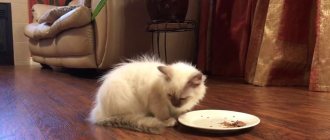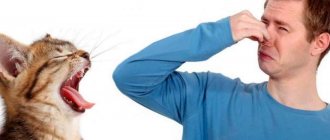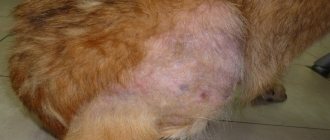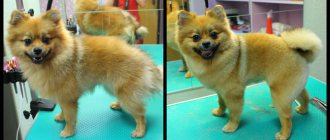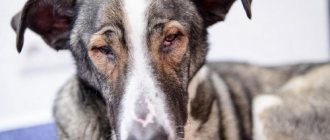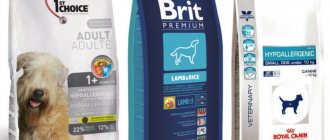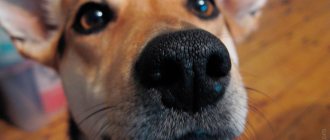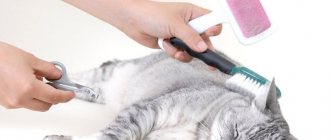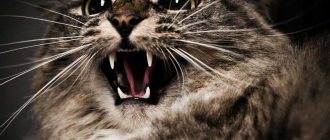Breeders do not like to sell puppies to beginners. This is a fact, and not an attempt to insult the latter. The thing is that newly-minted Pomeranian owners (and others) never listen to recommendations. They know everything themselves.
As a result, problems with teeth, intestines, and alopecia in the Spitz begin. We will dwell on the last problem in more detail. This phenomenon occurs too often, especially among show dogs.
Feeding
Breeders are a patient and self-possessed people, but even they can lose their temper. And who would like it if their puppy ended up in unsafe hands? Then the unfortunate owners call and cry: “The Spitz’s hair is falling out, what should I do? After all, the exhibition season is just around the corner!”
The breeder begins to ask counter questions. And the first of them: “What did you feed?” This is where it turns out that the dog really loves sausage, chips, pasta with sauce and other food. The puppy’s “parent” grabs his head and reproaches the new owners. He also warned that you should never give anything to a dog from the table.
The answer is mind-blowing: “The dog is asking.” Sometimes they say even better: “The dogs have been kept and fed this way all their lives. Everything was fine. You gave us a bad puppy, some kind of allergy sufferer.”
Dear owners of this furry pet, listen to the breeder’s advice on what to feed your Spitz puppy. You can’t give your baby any food from the table, never. If you decide to feed natural food, then these could be:
- Boiled meat without salt and spices (chicken, turkey, beef).
- Vegetables that do not contain starch.
- Dairy products (kefir and cottage cheese).
- Hard-boiled eggs, but not more than twice a week.
- Boneless fish.
- Fruit - unsweetened apples.
- Cereals (rice, buckwheat).
Either feed your pet this way or high-quality dry food, there are no other options. Of course, unless you want to treat alopecia in your Pomeranian.
Is it dangerous
In many cases, Spitz hair loss can be stopped without the use of complex medications. It is necessary to provide proper care for the dog, give vitamins and probiotics. Animals do not suffer from baldness; it does not cause them pain. But they can freeze in low temperatures and get burned in the bright sun.
Unpleasant accompanying phenomena sometimes include skin infections, fungal diseases, peeling, and itching.
Good conditions, constant attention and care for your pet allow you to take timely measures and avoid serious consequences in the event of hair loss in a Spitz.
Poor care
Spitz hair is very dense, with a thick undercoat. She needs care, and this care is not limited to superficial combing.
It happens that the owner does not comb the wool enough. On the surface it appears smooth, but the undercoat begins to fall off. This is where problems like alopecia in Spitz arise.
What do breeders recommend in this regard?
- Brush your dog three to four times a week. During molting - daily.
- What kind of comb should a Pomeranian have? This is a slicker with dense teeth. She should not only “slick” the fur superficially, but also thoroughly comb the undercoat.
- They say that a Spitz should be washed every six months. It's a lie. The dog is washed weekly, using high-quality shampoo and conditioner.
- When brushing your dog, moisten the fur. A spray bottle will help with this.
Why do Pomeranians start to go bald?
One of the most common causes of alopecia is improper care of the pet's fur or a complete lack of care. The coat of this breed is incredibly luxurious - thick soft undercoat and hard guard hair.
That is why you need to comb your Spitz daily (or once every 2-3 days, at least!) using a slicker brush or a massage brush. It is impossible for a dog to have a lot of tangles. Thick fur must be massaged so that the hair grows and the hair follicles do not fall asleep - this is why Pomeranians are brushed so often. Wash your Spitz once a month or a little less often.
Advice! Before combing, apply a spray to your pet's fur, and at the end of bathing, apply conditioner, which then needs to be rinsed off.
Also, the cause of baldness is poor nutrition - this is an unshakable rule that owners love to break. After all, the Spitz stands so touchingly on its hind legs in front of you when people are eating and begs for something tasty that many cannot resist giving the dog junk food (sausage, chips, sweets).
Important! Feed your Spitz either special dog food or natural food, but properly prepared. Any food from the master's table should be prohibited.
Walking is no less important for a Spitz - although the dog is decorative, it needs to be in the fresh air in any weather. Walk pets 2 times a day for at least half an hour, but it’s better to walk for an hour. An active Spitz will not get tired, and there will be no problems with the coat. This breed does not need overalls for walking, except when walking in dirty weather. After walking without overalls, the pet simply washes its paws and the area under the tail.
It happens that during the first molt, which ends at 10 months of age, the puppy does not change the baby undercoat to guard hair, but begins to go bald on the hips, back and sides. In this case, you should immediately contact a veterinarian and begin to identify the causes of baldness.
Important! One of the characteristic signs of alopecia is excessively dry hair that looks like it has been burned. If you haven't experimented with changing shampoo, this should alert you.
Another possible cause of baldness is cutting your dog's hair too short. Remember that the length of the coat should not be less than 1.5 - 2 cm.
Walks
Caring for your Spitz also includes regular walks. They walk the dog every day. This is not an indoor dog that can go to the toilet in a diaper. Spitz requires physical activity.
Just do not need to pack your pet in clothes, even in winter, do not do this. This dog has such fur that it can protect him from the cold. The only thing you can do during mud and slush is to use a dog raincoat.
Treatment options
To achieve a quick and lasting result, the treatment of alopecia must be approached comprehensively. Owners of a Spitz with baldness should reconsider their diet, grooming, and walking. On the recommendation of a veterinarian, when feeding a dog, owners include probiotics in the diet to improve the functions of the gastrointestinal tract, and vitamin complexes to restore and strengthen the immune system. If hormonal problems are detected in a Spitz, drug treatment is prescribed, sometimes castration or sterilization.
With alopecia, the Spitz's skin immunity decreases - there is an increased risk of fungal or parasitic skin diseases. A course of medicinal and then systematic use of preventive antifungal shampoos is recommended. Treatment against ticks, fleas, and lice should be carried out at least once every 4 months.
Read Allergies and Labradorite: effective ways to treat the disease
Symptoms of the disease
It seems that the owners are caring for the dog as expected, but they begin to notice that the coat becomes dry, and then suddenly quickly falls out. This is alopecia in a Spitz.
Puppies aged 4-6 and 10 months are susceptible to the disease. But the disease can appear later, for example, at one year of age. It happens that very adult dogs, aged 8 or more years, get sick with it.
What should the owner do if his dog looks like a slightly hairy rat - the head and tail are “woolly”, and the body is bald? In this case, urgent measures need to be taken.
Hairless Pomeranian Spitz: features of alopecia
Alopecia occurs in 16% of Spitz dogs. Males are more susceptible to it than females. The disease usually develops in puppies and juniors at 10 – 12 months and 3 – 4 years. But sometimes baldness occurs in dogs at the age of 9–10 years.
The exact reasons why Pomeranians become hairless have not been established. As well as whether the disease is genetically determined. And nurseries do not guarantee the return of a bald puppy.
It has been established that baldness is directly related to disruption of the endocrine system and improper maintenance. The disease is called alopecia X (alopecia “X”), and also black skin disease (BSD or BSD) due to the fact that the bare areas turn black when exposed to sunlight. But they can stay pink.
The most dangerous period is 4 months. At this time, puppies exchange “baby” fluff for “adult” wool. If the puppy has a cottony undercoat, does not undergo a normal coat change, and shedding is delayed until 10 months of age, BSD develops.
Baldness begins with small bald patches on the neck and back in the tail area. Afterwards, the hair falls out on the sides and body, but usually remains on the head and paws.
Alopecia X is a cosmetic defect. The dog does not experience discomfort or itching. However, the risk of a fungal infection is high. In addition, in the cold the orange will freeze.
Run to the doctor
What is the treatment for alopecia in a Pomeranian? First, they take the dog and take it to the veterinarian. The specialist does the necessary tests and makes a diagnosis. If alopecia is confirmed, then the animal is prescribed various vaccines. These include the drug "Polivak-TM", which is administered intramuscularly with a break of 10 days. First in one hind paw, after a set period of time in the other.
Diagnosis of the causes of baldness
If a Spitz exhibits dry fur, dandruff, lack of guard hair on the back, hind legs, tail, or a receding hairline, the owner is advised to contact a veterinarian to find out the reasons. The doctor examines the dog, finds out the duration and manifestation of clinical signs, takes blood and feces tests, hair and skin scrapings for microscopic and biochemical examination.
If hypothyroidism is suspected, an ultrasound of the thyroid gland is performed. Based on the research results, treatment is prescribed. With timely diagnosis and treatment, Spitz restores the integrity of the coat within 2-3 months. If the process of baldness is long-standing and advanced, treatment may take up to 1 year.
Breeders' recommendations
How do dog breeding professionals recommend treating the disease? For alopecia in a Spitz, they, like veterinarians, focus on the Polivak-TM vaccine. What else do breeders offer?
- Bathe your pet with Nizoral shampoo. It is sold at any pharmacy. This must be done every three days. Why, if the veterinarian did not identify a fungal disease? After all, Nizoral fights fungi. The fact is that many fungi are difficult to diagnose. Shampoo won't make it worse, that's for sure.
- Treat your Pomeranian for fleas and ticks. Give any antihistamine. They mainly give Suprastin and Fenistil. During processing, an allergic reaction may occur, and the drug will help avoid this. Just choose one thing. There is no need to stuff all the pills that are in the pharmacy into your dog.
- You can buy PDE and rub it into the skin of the animal. PDE is an excellent prevention of alopecia in Spitz. What it is? It stands for denatured emulsified placenta. It is sold in pharmacies. Before rubbing the placenta, it is necessary to treat the dog's skin. To do this, take a good proven scrub and treat the dog’s skin. After washing off the scrub, the skin is blotted with a towel, excess moisture is removed and the placenta is rubbed in.
- Be sure to give your pet vitamins. Lactis Zoo and FortiFlora, which are sold in the form of oil, have proven themselves well. Follow the instructions strictly when planning to give them to your Spitz.
Shedding
Pomeranians, like other dog breeds, are prone to shedding. The fact is that each hair, having gone through its life cycle, dies, leaving room for new hair. Pomeranians have a long and intense period of hair loss. A dog can shed heavily, losing about half the volume of its coat. There are several types of shedding - seasonal, age-related and hormonal.
Seasonal
Hair begins to fall out under the influence of the hormone melatonin, released in the pituitary gland as a reaction to changing climatic conditions. Such molting occurs in the off-season - in spring and autumn. By the warm season, the orange sheds its warm undercoat, and in the fall it loses its long hairs so that there is more space for a downy coat. If the dog is indoors and rarely goes outside, shedding occurs gradually throughout the year.
Age
At about four months of age, Pomeranian puppies experience their first molt. Baby fluff is replaced by coarse wool, and the color of the pet may change. First, the fluff disappears on the dog’s face, then on the body, and at the very end the collar and panties of the hind legs peel off. At the same time, molting can occur gradually or abruptly.
In the second case, especially with the rapid growth of the animal, the fluff is shed abruptly and the new appearance can shock the owner. The second stage of coat change occurs when the dog is one year old, and can become a smooth continuation of the puppy moult. The undercoat that has already appeared falls off within three months, giving way to coarse hair. The dog takes on the familiar appearance of a classic orange at the age of two.
We invite you to read: Autoimmune alopecia - treatment and symptoms of alopecia areata in an autoimmune disease
Hormonal
The female half of Pomeranians are prone to intense hair loss during estrus. And in the event of childbirth, noticeable bald patches may appear on the dog, or even almost complete baldness may occur. During this period, the pet must be fully fed, ensuring the correct set of vitamins and microelements in the diet.
Hair loss can be caused by hormonal imbalance. You need to pay attention to the following possible problems:
- bald patches near the female genitals may indicate excess estrogen formed in the body;
- a castrated female can rarely boast of a healthy coat; a lack of estrogen makes the hair thin and inhibits its growth;
- severe sudden hair loss can be caused by large amounts of cortisol;
- if the thyroid gland is malfunctioning, the fur becomes brittle and falls out on the chest and back of the animal;
Other reasons
Hair loss without signs of skin inflammation in Spitz dogs is called alopecia X. There is no clear answer to why a dog develops this disease.
What else causes the disease?
Wrong haircut. Not long ago, an image with a dog named Boo gained popularity on the Internet. It depicts a bald body with a furry head. And owners of furry pets rushed to cut their pets' hair, wanting to have a dog as fashionable as Boo.
The breeders were horrified, trying to convey to the owners that such a haircut is fraught with consequences, one of which is alopecia in the Spitz.
If you shave your pet bald, the hair follicles will fall asleep. And it’s not a fact that the animal will be able to grow again. More precisely, he will be able to transform, but it will look strange.
Secondly, owners of clipped dogs began to experience sunstroke and burns on their pets. Dogs do not have sweat glands, and baldness does not bring them relief during the heat, as inexperienced owners believe. On the contrary, the situation worsens, the pet suffers heatstroke.
Want to help your pet cope with the heat? Give him water more often, wipe his belly and paws with a damp cloth, and do not force him to play outdoor games.
Allergic reactions are a side effect of a “bald” haircut. The dog begins to be bitten by insects, and he, in turn, develops unimaginable allergies. The owners are guilty of food, and the problem is the bald skin.
Dear Spitz owners, do not experiment on your pets. Please, if you decide to cut your pet's hair, leave 3-4 centimeters of fur.
